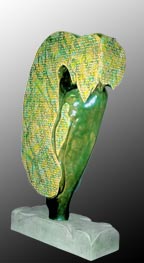
|
|
|
 |
Greensquat #6 |
The development of a sculptural aesthetic originates in the most primeval responses to our environment--species survival depended on it. Bifocal vision, the ability to see in three dimensions, is a selected evolutionary trait in all fauna, it configures contour and mass in the same moment of perception, and as such must be analogous to a Pluralistic universal.
On the other hand, Platonic Idealism, a conceptual construct, has two-dimensionalized reality by a process that must also have its roots in evolution as the ability to form mental patterns and discern similarities. Still, out--of that idealism --that originals do not occur but are mere metaphysical manifestations--comes a disbelief in experiences that are physical, (except where the emotional response is instinctual and can be discounted as outside the mental realm).
With idealization we simplify, discarding nuances of complexity that are, in fact, the layers of perception that reifies the world continually. This simplification has reduced our ability to appreciate, and even recognize, the differences between form and design; it may even be the underlying cause of our inability to formulate a multiple worldview that includes others. We have incorporated idealism to the point where the only ideal is ego, defined as either ourselves or as a god.
This ontological reductionism has imbued reproductions, symbols and images with an unwarranted substantialness at the expense of original three-dimensional objects, and has destroyed aesthetics by relegating it to mannerism. This loss of aesthetic sensibilities is due to our distain of interaction with truly original objects, as without them nothing has character or individuality.
Without originals nothing is appreciable, as there is always a replacement and there is no need to revere anything. Even worse, we lose ability to imbue specialness; we forget how to make subtle distinctions --both in aesthetics and emotions--we are therefore left with only the banal and instinctual.
Today it is rare to experience the rapture of response that follows when confronted by the reality of art-in-three-dimensions, therefore impossible to experience its existence or understand its impact. We are left without the ability to de/re/fine our environment and our lives. Without a sense of speciality, or preciousness and history, without repeated use and exposure, experience is meaningless and sadly without value.
As aesthetics is to heighten senses, anesthetics then is to reduce them; we have anesthetized the world through the over abundance of Idealism's alter-ego, endless copies. It is as if we had removed one eye and therefore saw the world as flat, without perspective, denying depth, understanding only surface. It is by way of aesthetics that we arrive at beauty; everyone knows when they feel it as sexual attraction but there's a need to explore the differences between instinctual responses and the other one that happens when we are flooded with awe and wonder, to the point where it is unspeakable.
The Aesthetic Experience --close to lust/passion--is so close in fact that it's all that remains when there is nothing to compare it with, and is the reason we feel beauty is a measure of lust, not incorrectly but with distinctions. Lust is active while aesthetics is religiously gripping in its quietude, filling the viewer with emotions from different hormones, different root sources. The object is to separate them and then, because of their propinquity, recombine them, allowing the awe and passion to generate a fresh awareness, a focus on the present-ness of living and an appreciation for the specialness of it. It is for these reasons that sculpture has a greater access to utilize a viewer's sense of perception in the basic organic fashion; three-dimensional reality's appeal to complexity is that it mirrors life.
![]()
|
Essays on Sculpture |
|
Greensquat #6 |